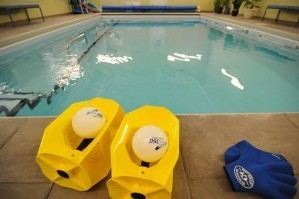INTRODUCTION TO AQUATIC THERAPY

If your therapist or doctor feels that you would benefit from aquatic therapy, this will help to acquaint you with what to expect.
WHAT TO BRING
A swim suit, towel, flip flops or another pair of footwear to wear between the locker room and the pool area. Please bring personal items such as shampoo, body lotions and a comb, etc. Bring a lock to secure personal items in the lockers available. If you choose to wear your swim suit, please remember to bring underwear for the trip home! If you choose to wear shorts and a t-shirt, please be cognizant of the wet t-shirt look and avoid wearing revealing T shirts, ladies.
WHAT TO EXPECT
You do not need to know how to swim to participate. Fear of the water is not uncommon and can be addressed with your therapist. It is hard to fall far in the water and balance issues are best addressed in this type of environment. You and your therapist will establish a program that will meet your needs and you will receive a laminated copy to refer to when you progress to an independent program. We at PT360 offer the opportunity for current and recently discharged patients access to the pools during the working hours for up to 3 months following discharge from PT. We ask that you call ahead to confirm that there will be adequate space for current patients scheduled for therapy and that you purchase a pool pass card for $50.00 for 10 visits.
Usual after effects of the first several pool therapy sessions include sleepiness, soft tissue achiness of stiffness, or fatigue. These are symptoms resultant from exposure to the unseen forces in the water acting on your body. You will need a few sessions to allow your body to accommodate to their influence. Drink lots of water to stay well hydrated before and after your aquatic therapy session and rest as you feel the need to allow these changes to start happening. Change is what therapy is trying to create and this change will be the reason you will feel different. Communicate any areas of concern with your therapist. CONTRAINDICATIONS: include any active infection or virus, open skin areas of any kind where any fluid is weeping out of the skin, uncontrolled incontinence, seizure activity, or hypertension (high blood pressure).


